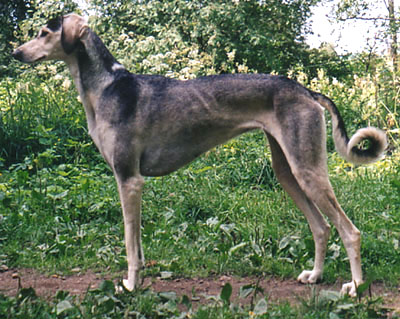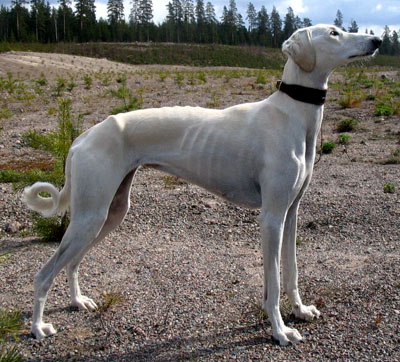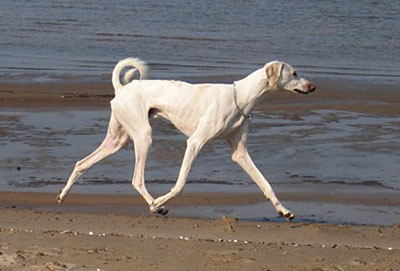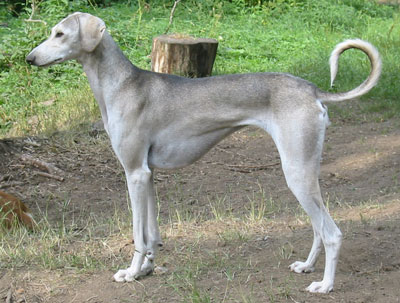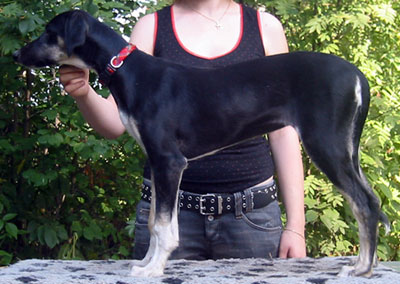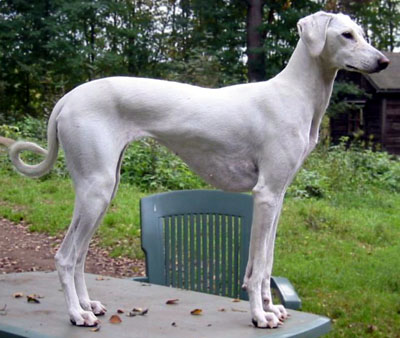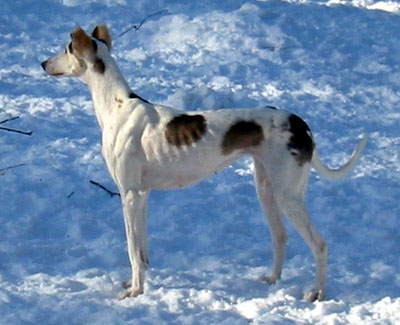What Salukis have you had/do you have at home?
My first Saluki was the bitch El Hamrah Jacinth (Akasha, b.
20.3.1996). To my great sadness she died in a car accident on
Christmas -97.
In the spring of -98 I imported the Swedish bitch Ibriz Uzume
(Asheerah, b. 26.2.1998).
Around the same time I also gave a 6 year old bitch, Dyanitos Bazzia,
(Zia, b. 8.2.1992), a new home. She was diagnosed with malignant
tumors at 7 years of age and was operated on three times, but was
feeling well the entire time. She spent her twilight years with my
mother and passed away at 13,5 years.
In addition to Asheerah I have 7 desert bred Salukis at home:
-the smooth bitch Farha al-Faifa (Farha, b. 16.6.1999);
-the male Sami de Hamadan (Muhafhaf, b. 26.5.2001);
-the smooth bitch Thurayah (Lublub, b. 6.5.2002);
-the crop-eared bitch Basma (Basma, b. 15.1.2003);
-the smooth male Khattaf (Khattaf, b. 5.10.2004);
-Lublub's daughter, the smooth Qashani Nujaima al-Hasa (Nujaima, b. 17.6.2005),
-and Basma's daughter Qashani Tayra al-Sham (Tayra, b. 30.5.2006),
-as well as Basma's son, Qashani Talaqa al-Wajh (Iso H, b. 30.5.2006),
who is still looking for the Right Home.
I co-own Farha's daughter, the smooth Qashani Habwa Min Farha (Habwa,
b. 1.3.2003), whom I had to rehome as she was not enjoying life in a
pack. In addition to Habwa I co-own the smooth male Idan Atiq Rafiq
(Rafiq, b. 26.8.2002), and Lublub's smooth son Qashani Najm al-Saudi
(Naali). |
Have you imported Salukis and if so, what and why?
Most of my Salukis are imports and the reason for this is a desire to
bring new blood to the Finnish gene pool.
My first import Asheerah came from Sweden in 1998 precisely so that I
could bring in slightly different lines. Her sire is my old favourite
El-Cazzino Cajar, whose pedigree is mainly Knightellington/Windswift
with some desert blood. Asheerah's dam Ibriz Raziza carries old
Ibinores lines as well as fairly fresh desert blood through Sindah
Manik. Due to Asheerah's brother's autoimmune disorder I have not bred
from her.
I had always dreamt of a country of origin import and in -98 while
reading the book "The Saluqi – Coursing Hound of the East" I realized
that obtaining a desert bred might be possible. After a couple of
years' hard work Finland got its forst two desert imports in 2000.
They were Farha al-Faifa, at that time 8 months old, and Zafran Asli,
4 months, both from Israel. The male "Safi" went to Seija
Kotti-Rantala and Farha, Bedouin bred in the Negev desert, moved in
with me – to be my trusted companion and soul sister. These two became
the parents of my H-litter.
In 2001 I imported Sami de Hamadan from France – his parents are
Bahraini imports. I had hoped he would be a stud dog, but he fell ill
with epilepsy at age 1 and so he became purely a pet – and a lovely
one at that.
In 2002 I imported the tiny Thurayah aka Lublub, from Qatar – her
parents are Saudi Bedouin hounds. Lublub is a laugh a minute,
good-humored and forward and a real lapdog. She's the dam of my
N-litter and I hope to get more pups from her eventually.
In 2003 I was enchanted with the pictures of a smooth grizzle male
called Idan Atiq Rafiq, and so my friends Mia Salmi, Sami Suomela and
I bought him from Israel. He lives with Mia and Sami as their dog. He
is the sire of my N-litter.
I had long dreamt of a Syrian Saluki and in 2004 the dream became
reality when the then 17 months old Basma arrived in Finland. Her
arrival was really a joint effort: my Syrian friend Basil Jadaan found
Basma for me and gifted her to me, and the cost of the importation was
shared between Kalle Rautavuori, Sirkku Moilanen, Katja Pellikka and
myself. In return they can have pups from me or use one of my males
for their bitches. Basma is the dam of my T-litter.
In 2005 Basil gave me another Syrian Saluki. Then 1 year old, the
handsome and beautifully moving Khattaf arrived in October 2005 and I
hope he will sire some puppies for me – time will tell if that dream
is realized.
Do you work with foreign breeders and if so, how?
No real collaboration, some tentative ideas here and there, but mostly
we just keep in touch and share experiences through correspondence.
|
Tell us about the litters you've bred!
The H-litter, b. 1.3.2003, 3 males and 6 bitches, 1+2 feathered, the
other smooth
Zafran Asli (s) x Farha al-Faifa (s)
From the beginning Farha and Safi were imported for breeding. The idea
was initially to use them with Western Salukis, but after getting to
know these awesome desert Salukis I wanted to combine them. Both are
from Israel and as such of very similar type, strong yet graceful,
lightly moving, balanced and intelligent hounds whose relatives have
been tested in the field. Farha's sire and doublegrandsire were
particularly famous hunting hounds. An added bonus was the great love
Farha and Safi had for each other – even now Farha is thrilled to meet
her mate.
I got pretty much the kind of look I expected: varied, but all
typical, very well-moving Salukis. Lookswise I am quite pleased with
the litter. It consists of three types, one solid, very old Sinai, the
other daintier and slower to mature, the third something inbetween.
I'm not entirely satisfied with all the temperaments – some of the
pups lack the unshakeable confidence I've come to expect of DBs. They
are wonderful people dogs, very loyal and affectionate, but some have
a certain insecurity that manifests itself as occasional dog
aggression and in one of the pups as severe separation anxiety.
We experienced disappointments in terms of health. A couple of the
pups had recurring ear infections which for one of them stopped when
kibble was dropped from the diet. One, Hurra who went to England, was
poorly for over a year with something that included weakness, bleeding
gums and hematomas, but was never definitively diagnosed. She was
treated with cortisone and then with doxycyclin as a tick borne
disease was suspected. For a while it seemed that she was on the mend,
and then she crashed again. She died at two years old of heart
failure.
In the spring of 2005 the male Hajum had an infection of the
lymph nodes, at that time thought to have been bacterial. He
recuperated after a long treatment with antibiotics, but fell
seriously ill in February 2006. The diagnosis was immunological
polyarthritis, an auto-immune disorder. At present his cortisone
treatment is over and we hope for the best. It now looks as though the
previous lymph node infection was related to this illness, along with
the tendency of the tips of his ears to bleed in very cold
temperatures.
In light of Hajum's condition it now seems fairly certain that Hurra's
illness also was of the auto-immune kind. I will not breed on from the
H-litter, nor will I breed Farha again.
After the pups Farha was
allergy-tested because of a winter itch, and the test showed reactions
to house and dust mites. Luckily this manifests itself only as
occasional, fairly mild itching in wintertime and has not needed
medication. Qashani Hiba Bint Farha has had her elbows and hips
x-rayed unofficially, all was in order. Qashani Husn at-Tali switched
homes in Denmark and escaped from his new owners and was hit by a car.
He was 2,5 years old when he died. I hope all the H-pups will remain
healthy from now on and that my other desert lines will have healthier
futures.
|
|
The T-litter, b. 30.5.2006, 3 males, 2 bitches, all feathered
Barak x Basma
I had intended to use an Iranian male on Basma, but changed my mind a
month before the breeding, when to my joy I realized that it was
possible to use a Syrian import, the 10,5 year old Barak, reciding in
Switzerland. I've always admired the Syrian Salukis and the idea of
doing a 100% Syrian breeding was very appealing. This was also the
first time I used a Saluki that already had offspring. Barak is the
sire of the Menjad litter born in France in -98 and the Achthamar
C-litter bred in Germany in 2005. He has several grandchildren in the
USA.
The criteria for the choice of breeding animals was the same as
before: up until the breeding (I can of course say nothing certain
about the future) completely healthy Salukis with wonderful
temperaments from good country of origin hunting lines. In addition
Basma and Barak have both hunted capably in the desert themselves
before being exported to the West. They also compliment each other
nicely. In type this is a very different breeding from the two I had
done previously, but this is not a shift in breeding goals, but a
continuation of my breeding philosophy – I like all original types and
do not wish to confine myself to one type in my breeding. It will be
interesting to follow the growth and development of these pups.
We travelled to Switzerland for the breeding and spent a week with
Barak's owner Susi Muehlemann (Tepe Gawra). Barak proved just as
wonderful as I had hoped: a lovely temperament, medium size,
handsomely built, and in good condition despite his age.
Basma, as my other bitches, was also a wonderful mom and as I write
this the pups are 6 weeks old and very outgoing and mischivieous. If
my previous litters have been energetic, these pups are even more so –
they are also larger and more precocious. I was astonished when at
well under three weeks they began to howl in unison daily like little
wolves! Their coordination has developed quickly as well. As tiny
blind pups they already did laps around the 2 meter long whelping box
and at three weeks they were already well up on their feet. They have
nice, balanced builds and have very pretty faces and expressions.
How do you plan breedings and how do you choose breeding animals?
The pedigree is paramount, even more important than the individual. I
look for country of origin lines where hunting abilities are strong
and where that ability has been consistently tested generation after
generation. I trust that function-based breeding ensures and even
demands correct structure, temperament, intelligence and instinct.
I try to choose individuals that complement each other, although I am
not frightened of or deterred by heterozygosity in the genotype or
even the phenotype. My goal is pups that are of the same quality,
rather than the same type. There's a distinct difference. The
combination has to "feel right". The prospective parents have to look
balanced, like hunting Salukis, without exaggerated features. The
whole is key and details secondary. The Western obsession with details
is in my opinion a bit questionable, such as the much talked about
"correct Oriental eye", which in the West is perceived as an eye of a
certain shape, placement and colour – the darker the better. Many
Arabs and Kurds however don't place much importance on eye colour and
if they do they often prefer a lighter eye that will give the dog "the
look of eagles". The question then becomes what in fact constitutes
the "right" Oriental eye? In Dan Belkin's words, probably the one that
sees the best!
I understand the allure of breeding for details and conformation, and
the temptations of linebreeding and even inbreeding. The traditional
Western breeding philosophy of building pedigrees to produce one's own
line is attractive and a linebred pedigree always makes for
interesting and informative reading. It is always fascinating to read
about the systematic work of a determined breeder, who seraches for a
quality lacking in his or her line, and then anchors that quality into
the line with skillful linebreeding. However, to me it is a practice
that is best left in the past, particularly as it in practice entails
a very limited use of breeding material. Especially in a breed as
ancient and as stable as ours, I feel it is questionable to continue
with inbreding or very tight linebreeding. There are many correct
Saluki types and they are quite firmly established, which easily makes
linbreeding tinkering with detail or a creation of a signature type,
neither of which I can reconcile with preserving an ancient hunting
hound. This of course is just my personal opinion.
Health and temperament are absolutely the most important factors in
choosing breeding animals – a difficult, very shy hound would not do
well in the hectic lifestyle of the Bedouin, and a hound with poor
health would not survive long in the desert. In our Western society
too a dog of weak character is difficult, and a sickly dog a source of
sorrow and concern. So naturally I strive to breed healthy,
goodtempered Salukis. I also only use breeding animals that have been
used sparingly or not at all, this to contribute to a wider genetic
base. In the future I hope to mate Lublub with Khattaf, provided all
stay healthy and whole.
How and when do you choose a promising puppy?
I refrain from making my final choice until the pups are about 6 weeks
old and I can see how they move and carry themselves. I look for a
harmonious balance in both appearance and temperament. I do follow
them closely from birth, and a pup that is particularly strong and
vital at birth immediately scores "bonus points" with me, and I follow
that pup especially closely.
|
What is the importance of hunting ability in this day and age?
If we think purely of Finland, then we have an obvious problem. The
breed's original function is key to preserving the breed. The Saluki
is so completely the product and embodiment of that original purpose,
and that purpose has been instrumental in ensuring that the breed has
stayed unchanged for millenia. And yet in Finland it cannot hunt live
game in the same way or with the same frequency as in the countries of
origin. Racing and lure-coursing are fun hobbies, but can not measure
hunting ability, and without adequate tests of hunting ability we
cannot preserve optimal function in our hounds.
So what to do? I wish I knew! My answer is to try continually to bring
country of origin hunting hounds into my breeding in the hope that
that functional ability stays fresh in the gene pool. It's not the
perfect answer nor is it a permanent and completely reliable solution,
but it is the best I can do under the circumstances.
Some feel that the Saluki in the West should conform to the demands
and limitations of modern society, and that it's original function is
a thing of the past. I want to believe that we will get back our
hunting opportunities. Above all I feel the Saluki cannot be preserved
by altering its function. Shows leave too much room for interpretation
and change, both deliberate and unintentional. The Saluki's purpose
defines its conformation, temperament and intelligence, and vice
versa. Its original function sets the parameters within which the
breed must stay to function correctly and thus ensures breed type -
exaggerations don't work in practice and are therefore naturally
weeded out. In our society, without the parameters defined by
function, there is too much room for "creative" breeding and that is a
problem. Also, the things that make a Saluki a good hunter are often
things that cannot be seen. Without hunting we have no way to test
those things and that is the core of our dilemma, whether we start
with desert or Western lines. You cannot change one aspect of the
breed without affecting other areas as well – at which point what we
end up with is not a Saluki, but a Saluki-like dog.
How do you feel about the importation of country of origin Salukis, so
called "desert breds"?
Clearly I am in favour of it as I started it here! New blood and the
widening of gene pools is always a positive thing, whatever the breed.
As we are lucky enough to have a breed that is still used for its
original purpose in its countries of origin, it would be shortsighted
not to take advantage of that while we still can.
I feel desert imports are a valuable addition to the gene pool not
only for the new blood they represent, but also because they give us
the opportunity to add tested hunting hounds to our lines. Hounds that
have been tested and found functional in the field for countless
generations, in a way that we cannot do in our part of the world.
Hopefully they can help us retain that funtion or the potential for
it, and that way also ensure the preservation of the right temperament
and structure.
An added bonus is the harsh background of these hounds, which
hopefully is beneficial in terms of vitality and resistance to
disease. The mortality is high in the desert and far from our Western
mollycoddling, which in terms of the population as a whole can only be
a plus. No population is 100% healthy, that's a biological
impossibility, but surely a system so affected by natural selection
helps to weed out unsound structure, temperament, and individual
disease and weakness. The mere fact that young puppies have to survive
in difficult conditions, makes for a healthier starting point than in
the West, where weak and sickly pups are often kept alive through
extraordinary means.
How do you see the health status of the breed?
On the whole the breed is healthier than most other breeds, but I
would like it to be healthier...Which lines ultimately proove
healthier than others is no doubt largely dependent on chance and the
luck of the breeder, but if certain problems crop up time and again in
certain lines, then it is probably adviceable to start anew, as
painful as that is. These are issues that all breeders of all breeds
eventually have to confront. Luck and breeding choices determine how
radical the required actions will be.
The Saluki rarely suffers from structural weaknesses of the bone.
Autoimmune diseases are the breed's stumbling block, which is tricky
as a correct diagnosis can be difficult and there is no test for
carriers. This makes it difficult to draw lines and make reliable
breeding decisions. Health considerations, along with finding the
right homes for puppies, are the most difficult aspects of breeding.
It is very difficult to make informed decisions based on scetchy
diagnoses, particularly when dealing with diseases where the mode of
inheritance is unknown. More information on these issues is needed for
novices to have some kind of clue as to how to proceed. It would be
wonderful to learn more from veteran breeders, their opinions and
their solutions – what health problems they've encountered, how they
have reacted to those problems, and whether the decisions made have
been succesful.
Describe your ideal Saluki. Name the best Saluki you've bred and the
best bred by someone else.
Of the Western Salukis I've seen in the flesh, the following are
examples of individuals that have made an impression: Ibinores
Khashendi, Sahrai Ratima, Tadj Mahal Bali Gyalam, Kuriirin Diora
Deverre, Wallaby's Qazz Qamaran, Lusaki Zitah of Abu Hakim, Halaah
Dadaelis El Hamrah, Abu Hakim Aleya, and Nordwart Said Hakim. Nordwart
Errai combined charisma and speed in a nice way.
My biggest favourites and closest to my ideal are country of origin
Salukis. In Syria I met my friend Basil Jadaan's smooth tricolour
bitch Tayra, no doubt the most beautiful Saluki I've seen anywhere.
The quality of the Syrian Salukis was awesome – the most amazing
Salukis in the world!
Of my own Salukis my Farha from the Negev desert and my Syrian import
Khattaf represent my ideal Saluki. The Salukis I've bred myself are
still young and all are dear to me, but at this time the smooth bitch
Qashani Nujaima al-Hasa appeals to me greatly. She is very balanced
and moderate and a very agile and surefooted runner.
My ideal Saluki is a skillful, fast, agile and intelligent hunter. A
square or slightly shorter than tall, longlimbed, graceful but strong
sighthound with light, springy movement and strides that are not
overly reaching or with a high kick in the back, but instead with
steps that have a prancing lift. A reasonably wide back skull and a
strong, not too long muzzle, high-set expressive ears and an
intelligent gaze regardless of eye colour. Arched toes, strong pads. A
moderately long, curved tail – I don't pay much attention one way or
another to how it is carried – neither did the original standard. A
deep and roomy chest and a beautiful tuck-up. A strong topline with an
arch over the loin. Very moderate angulation, I want the legs under
the dog both standing and trotting. A courageous, obedient,
passionate, intelligent and loyal character, devoted to and gentle
with its owner. That's it.
What do you think about the quality of Finnish Salukis at the moment,
what are the most prevalent faults today? How do you feel the Salukis
have changed in the last 10 years?
Quality in what sense? Finnish Salukis do well at shows even in hard
international competition, but if I think of quality in the sense of
how well Salukis have been preserved in the image of the original
desert hunters, the answer is not as simple. There is a lot of
exaggeration – strange, overly long and refined, downfaced heads, weak
toplines, overangulated rears often in combination with very straight
fronts, inadequate tuck-ups especially in males... There are very
narrow hounds that lack fill-in seen from the front, and on the other
hand some very big and heavy pigeon-breasted Salukis. There's a lot of
overextension at the trot and also some very sloppy "cycling" front
movement, where there seems to be a lot happening but comparetively
little actual advancing – at least not very energy-efficient
advancing. On the other hand there are also several moderate,
beautiful, unexaggerated Salukis, that one can picture in a desert
environment – at the moment though they seem to be in the minority. In
the last 10 years – the time I've owned Salukis – a broader spectrum
of types has appeared in Finland, both historically correct types and
newer types that aren't correct. There seems to be more exaggeration
now than when I got my first Saluki.
What would you like to improve in the dogs you've bred?
I don't look at my breeding in terms of what details could be tweaked
in one direction or another, but instead in terms of how to preserve
the qualities of the parents and forefathers. The idea is to approach
desert Salukis as a student rather than trying to steer them in some
direction of my own making. So what I'd like to do with my breeding is
preserve the agility, the athletisism, the moderation and structural
balance, the working ability and intensity of character, the passion
and the loyalty that I see in the parents and forefathers of the dogs
I breed. All the purposeful funtionality of the desert hunters, both
physically and mentally. And of course above all I hope for good
health and temperament.
All dogs of course have their "faults", but I only consider
characteristics that hamper function, or that I don't recognize has
historically correct in terms of desert hunters, true and meaningful
faults. The dogs I've bred aren't perfect, but as a group they don't
have specific faults, which of course is understandable as their
parents all represent very different lines.
Do you have some advice for novice breeders?
I've only bred three litters so I'm a novice myself, but the most
important thing is to really study the breed properly before breeding
your first litter, so you have a clear picture of what the breed is
and has been, and you understand the responsibility you have to it,
and can visualize what it is you want to achieve with your breeding.
It's also important to choose your breeding stock with care – your
first, second , or even third Saluki may not be the best possible
foundation, if its health or other qualities don't mesh with your
expectations. In addition to that, if you stay open and honest, I'd
say you're in pretty good shape.
What are your hopes and fears for the breed's future?
I'm fear the continued narrowing of the gene pool and stud books
closing and no longer admitting country of origin imports, and
continual tightening of import regulations. I fear increasing
exaggeration and health problems. I fear that changing lifestyles in
the countries of origin will lead to decreasing numbers of hunting
desert Salukis. I fear that functional requirements will shift from
those of the optimal hunter to favouring those that create the optimal
lure-chaser. I fear that the correct Saluki intensity and pride will
change due to the demands of modern society. I fear that in the future
our dogs' opportunities and rights to free running and hunting will be
even more restricted. And most of all I hope all of these fears are
unfounded! I want to believe in a bright future and that the Saluki
can stay true to its heritage for centuries to come.
In conclusion I'd like to thank my puppy buyers for their sense of
camraderie and the love and good care they give their dogs! Hugs to
you all!
QASHANI SALUQIS, Micaela Lehtonen – A BREEDER INTERVIEW
PREVIOUSLY PUBLISHED IN THE FINNISH SALUKI-MAGAZINE 2/2006 |
